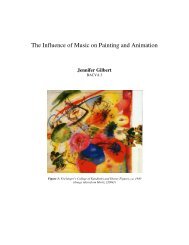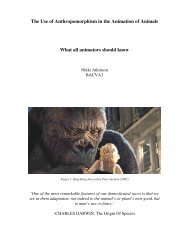An exploration into colour symbolism as used by - National Centre ...
An exploration into colour symbolism as used by - National Centre ...
An exploration into colour symbolism as used by - National Centre ...
You also want an ePaper? Increase the reach of your titles
YUMPU automatically turns print PDFs into web optimized ePapers that Google loves.
so an audience in China would e<strong>as</strong>ily pick up on this <strong>as</strong>sociation straight away. Elsewhere this<br />
would not necessarily be the c<strong>as</strong>e. The fourth <strong>colour</strong> is green, which represents new life, hope<br />
and a fresh beginning.<br />
Figure 30: Montage of stills illustrating the use of <strong>colour</strong> to symbolise the main themes of the film<br />
Interestingly, not all sources agree with the above <strong>as</strong>sociations made with the <strong>colour</strong>s of the<br />
four sections of “Hero”. Some reviews state that the green stands for peace for example<br />
(<strong>An</strong>on 7/3/06), and that instead of p<strong>as</strong>sion the red is representative of fire (Heiter 7/3/06).<br />
This is a clear example of the way that <strong>colour</strong>s can be interpreted depending on what country<br />
you are from.<br />
<strong>An</strong>other online review (Tran 7/3/06) lays claim to further <strong>symbolism</strong> within the film. It states<br />
that the First Emperor of China w<strong>as</strong> a scholar who believed in the five elements of fire, water,<br />
metal, earth and wood. Since the Emperor believed that he reigned in the cycle of water,<br />
hence the palace is completely black because of its <strong>as</strong>sociation with the element of water.<br />
©Laura Dilloway, NCCA 2006 37










